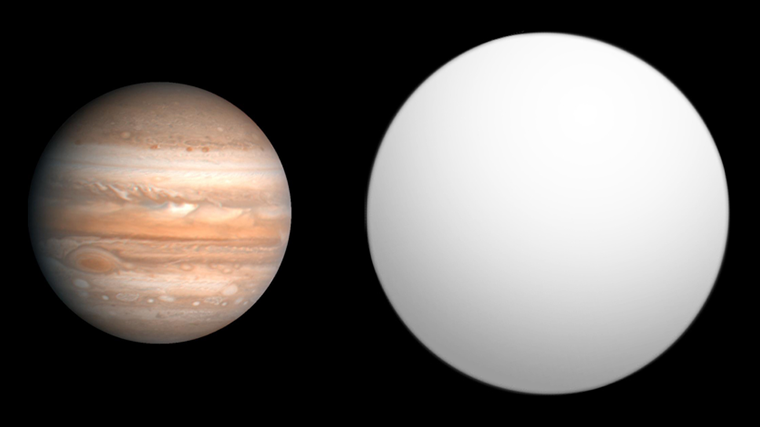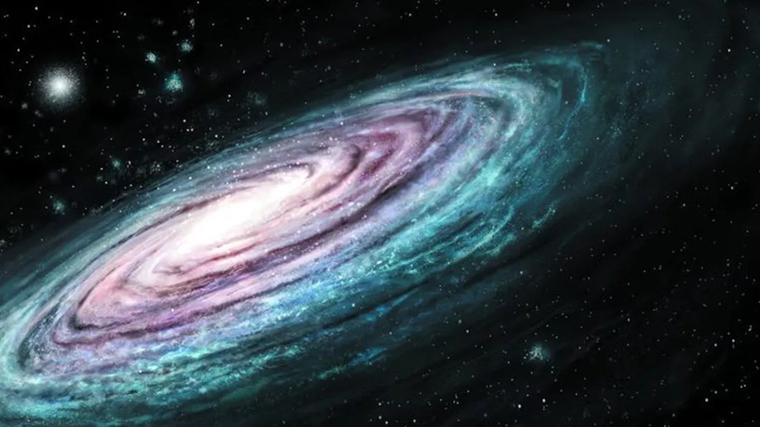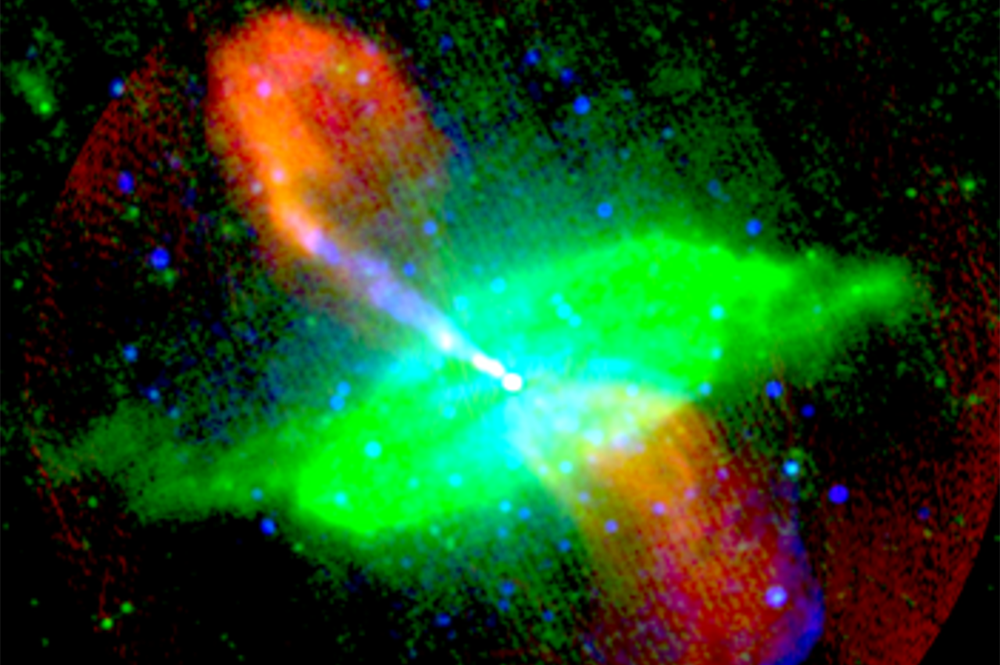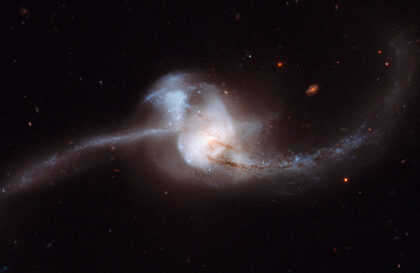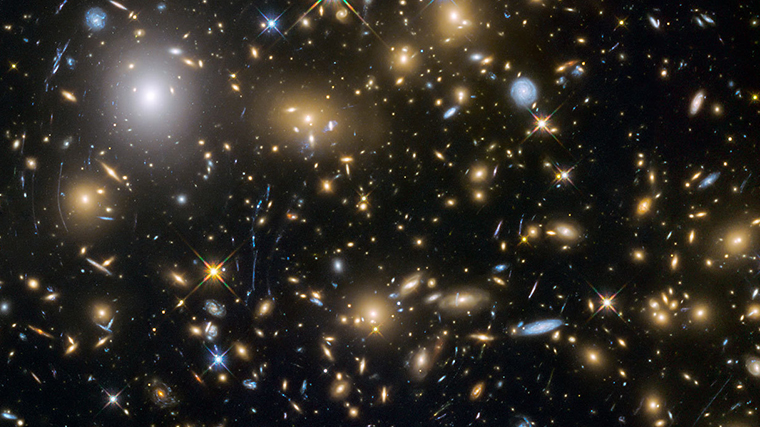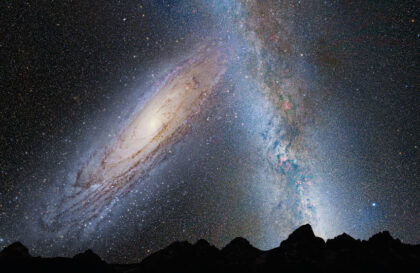At the center of the Milky Way, something unknown, dense, invisible through telescopes, and consisting most likely of no ordinary matter like a bullet pierced and made giant holes inside our Milky Way galaxy about 4.5 million years ago. The remnants of this event are still moving today. This Galactic Bullet (that’s what scientists called it) is traveling at about 560 km/s, and its traces can be found in the galactic halo.
Yes, the Milky Way is “shot through” and very dangerous.
What is the Milky Way?
The Milky Way is a spiral galaxy. It has a characteristic structure with pronounced spiral arms in which stars, gas, and dust are concentrated.
The Milky Way has a diameter of about 100,000 light-years. Estimates of its mass vary, but it is roughly between 100 and 400 billion solar masses. If you imagine the Sun weighs the weight of a pea, then the Milky Way weighs as much as a full pool of peas at your house.
Most of the Milky Way’s mass is 95% dark matter, an invisible form of matter that interacts with gravity but does not emit light. It is also believed that much of the universe is filled with dark energy. I wonder Are the Earth, people, and houses also filled with dark energy?
The Milky Way is populated by approximately 200-400 billion stars.
It has 5 spiral arms: the Swan arm, the Orion arm, the Perseus arm, the Sagittarius arm, and the Centauri arm.
At the center of the Milky Way, 8 kiloparsecs (26,000 light-years) from the Solar System in the constellation Sagittarius, is a supermassive black hole known as Sagittarius A with a star (Sagittarius A*). It has a mass of about 4 million solar masses and has a huge influence on the motion of stars and gas around it.
Our solar system is located in one of the spiral arms of the Milky Way, the Orion arm, 7.5-8.5 kiloparsecs away from the center of the Galaxy between the larger Perseus and Sagittarius arms at a distance of 1.5-2 kiloparsecs from both.
Why is our galaxy called the Milky Way?
The name “Milky Way” has ancient roots and is related to the visualization of the galaxy in the night sky. The ancient name “Milky Way” comes from the Latin term “Via Lactea”, which translates to “milky way”. This name comes from ancient myths and legends that explained the origin of the light streak visible in the night sky.
This bright streak we see in the sky represents the many stars, gas, and dust that make up the plane of our galaxy. When we look toward the center of the galaxy, we see a denser stellar population that creates a bright and diffuse luminous streak in the night sky. It is this bright streak that has come to be called the Milky Way.
In Ukraine, this streak is called the Chumatsky Shlyah. The word “Chumatsky” is associated with ancient trade and caravan routes. Chumaks were traders who traded between Ukraine and Eastern countries such as Turkey, Persia and others. During long nighttime passages on their camels or horses, they could see the Milky Way in the night sky. This luminous striped trail of stars was associated with the road that the Chumaks traveled, and they called it “Chumatskiy shliah” or “Chumatskiy path”.
Ukrainian culture also uses the name “Sribnyi Shnur”, which translates as “silver cord”.
Some Slavic languages, including Bulgarian and Serbian, use the name “Srebjrnitsa”, meaning “silver path”.
In Japanese culture, the Milky Way is called “Amanogawa” or “dirty napkin road”, because of the legend of a goddess who used a napkin to cross the sky.
In Arabic culture, the Milky Way is called “النهر الفضي” (Al-Nahr Al-Fidhi), which translates to “silver river”.
In some North American languages, the Milky Way is called the “dragonfly road” or something similar, because of the association with the movement of dragonflies across the sky.
Some languages associate names with the shape of the spiral arms of the Milky Way, such as in French “Voie Lactée” or German “Milchstraße”.
The Milky Way’s largest star?
VY Great Dog, also known as VY Canis Majoris, is a supergiant red M-class star in the constellation Great Dog at a distance of about 3,900 light-years.
Its diameter is about 1,800 times the diameter of the Sun. If the star were to replace the Sun, it would almost reach the orbit of Jupiter. In 5 billion years, our Sun could grow to that size.
VY of the Great Dog is one of the brightest stars known. Its luminosity is several thousand times that of the Sun.
The star is in the late stages of its evolution and is preparing to explode as a supernova in the next million years.
The atmosphere of VY the Great Dog has intense gas and dust emissions, which makes it particularly interesting to observe in the infrared.
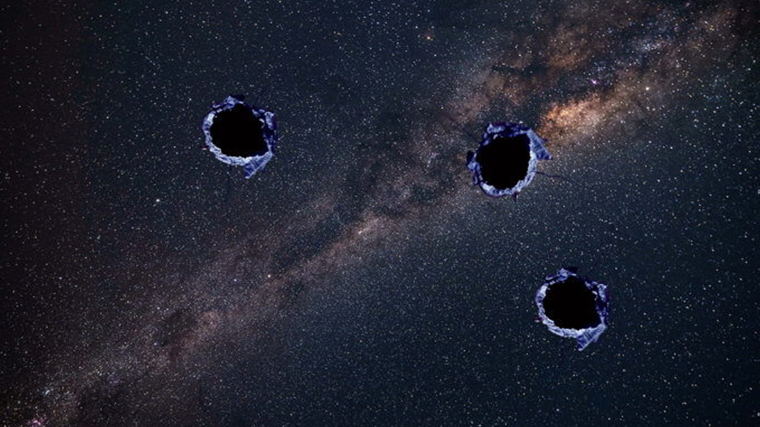
The largest planet in the Milky Way?
Scientists have determined that the number of planets in our galaxy ranges from 800 billion to 3.2 trillion. Not very accurate, but it gives you an idea. If we go back to peas, that’s about 2 to 8 pools filled with peas.
The largest planet in the Milky Way until 1999 was thought to be Jupiter. Jupiter is the fifth planet from the Sun. Its mass and size are so large that it has a significant impact on surrounding objects and even influences the structure of the solar system. Jupiter does not orbit around the center of the Sun like most planets, but around the barycenter, the point of gravitational equilibrium between Jupiter and the Sun.
Here are some basic characteristics of Jupiter:
Mass: about 318 times the mass of Earth. This is significantly more than the mass of all the other planets in the solar system combined.
Diameter: approximately 139,822 kilometers, which is 11 times the diameter of Earth.
Volume: Jupiter can hold more than 1,300 Earths.
HD 209458 b was discovered in 1999. It has a larger diameter than Jupiter, making it physically larger.
Diameter: Approximately 1.38 times the diameter of Jupiter.
Mass: About 0.69 times the mass of Jupiter.
Volume: Due to its larger diameter, the volume of HD 209458 b will also be larger than that of Jupiter.
It is important to note that HD 209458 b is a hot gas giant and has features that distinguish it from the planets in our solar system.
Kepler-37b is the smallest in the Milky Way, even smaller than Mercury.
